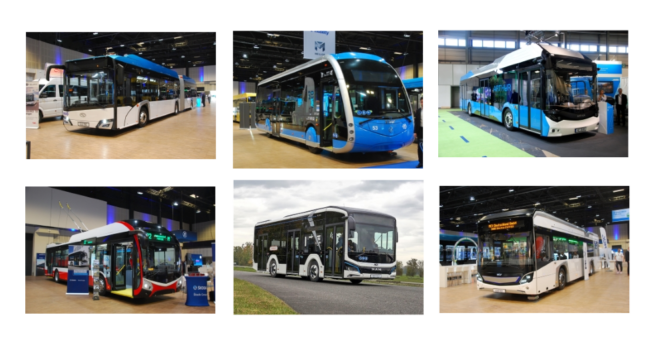
On 27 and 28 March 2023, the electric bus conference of the “Verband Deutscher Verkehrsbetriebe (VDV)”, Germany public transport operator’s association, took place for the 14th time. Because of its proximity to politics, the Cologne-based association chose Berlin as the venue. For years, the conference has been held at the “Estrel” hotel on Sonnenallee, a rather unusual hotel – in the author’s opinion – a colourful mixture of hotel in the conventional sense, “event centre”, theatre, exhibition centre … But it is precisely this mixture that makes the “Estrel” the ideal venue for a trade congress with associated exhibition. (Note: the Estrel is obviously an important address in Berlin: anyone entering Berlin on the A 113 cannot help but find the destination “Estrel” on the signposts.
The author visited the “Autonomous Driving” forum, offered for the first time, as part of the conference vornehmilch, a really exciting topic. At this point only this much: the very first speaker made it clear that autonomous driving will no longer be possible in the future. We will soon be short 80,000 bus drivers (eighty thousand!). His conclusion: “Either we drive autonomously or we forget all plans regarding the transition to public transport. The professions of train driver, tram or bus driver used to be attractive and highly respected. That is long gone. Today they are jobs that hardly anyone wants to do.” Even better pay will not change that. “Other sectors (with more attractive working hours) are also desperately looking for people. Then they pay more … and we are exactly where we are today.”
The exhibition
The “ElekBu” exhibition attached to the conference was bigger than ever this time. In the past, the “Electric Bus Fair” always made do with “Convention Hall 1”, but this year, for the first time, “Convention Hall 2” had to be used as well. Or in other words: the exhibition space has grown by 25 percent. So the electric bus is becoming increasingly interesting. This is evident not least from the fact that the Federal Ministry of Transport has just announced the promotion of one thousand (1,000) new electric buses. Quite a few of these will go to Germany’s two largest cities: Hamburg and Berlin. But Cologne (Germany’s fourth-largest city, also with more than a million inhabitants), for example, will soon have more than 100 battery-electric buses in operation.
Let’s take a look what the individual exhibitors showed:
Araiv (ZF)
ZF from Friedrichshafen on Lake Constance has been involved in the development and construction of electrically powered buses for quite some time. For example, there are drive technologies for electric buses from the company on Lake Constance.
Above all, however, ZF is very active in the field of autonomously driving shuttles. The “last mile” between the closest
Above all, ZF is very active in the field of autonomously driving shuttles. These cover “the last mile” between the nearest public transport stop and the passenger’s front door. For example, ZF together with partners such as the municipal transport company RNV is developing the autonomous shuttle system for Mannheim’s new Franklin development (UTM reported).
For these activities, ZF has now founded its own brand, which has been given the name “Araiv” (probably not coincidentally phonetically the same as the English “arrive”). Araiv builds the fully electric “shuttle”, which will reach its destination completely autonomously – i.e. without a driver. The vehicles can busry up to 22 passengers and do not follow fixed routes on their way, but are able to find their own optimal route. Of course, this presupposes that they are in constant contact with their environment. This contact is provided by lidars, radars, cameras and microphones installed in the vehicle. By the way, the Araiv Shuttle can travel at 40 km/h (if the legislator lets it).
The shuttles are “bidirectional”, so unlike a conventional bus, there is neither a defined forward nor a reverse direction. The shuttle arrives at its destination and immediately starts its return journey “from the spot” without having to turn around.
The shuttles can be used on separate lanes as well as in “mixed traffic” on the normal lanes of normal road traffic. In Rotterdam in the Netherlands, there is already a test track, but mainly on separate lanes, where six of these shuttles are on the road. Here it is being observed whether – and if so, how – the buss influence each other, how they behave at the intersections with other traffic secured by traffic lights, what happens if a bus from normal road traffic strays into the path of the autonomous shuttles … At the electric bus conference, ZF showed videos on which one could see that it all works quite splendidly.
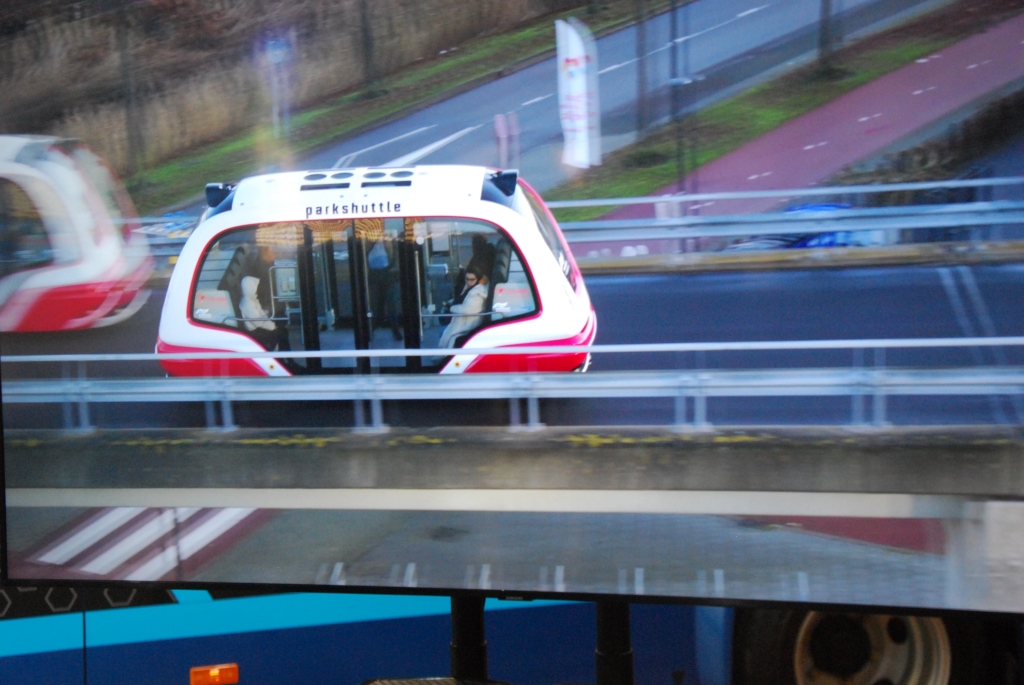
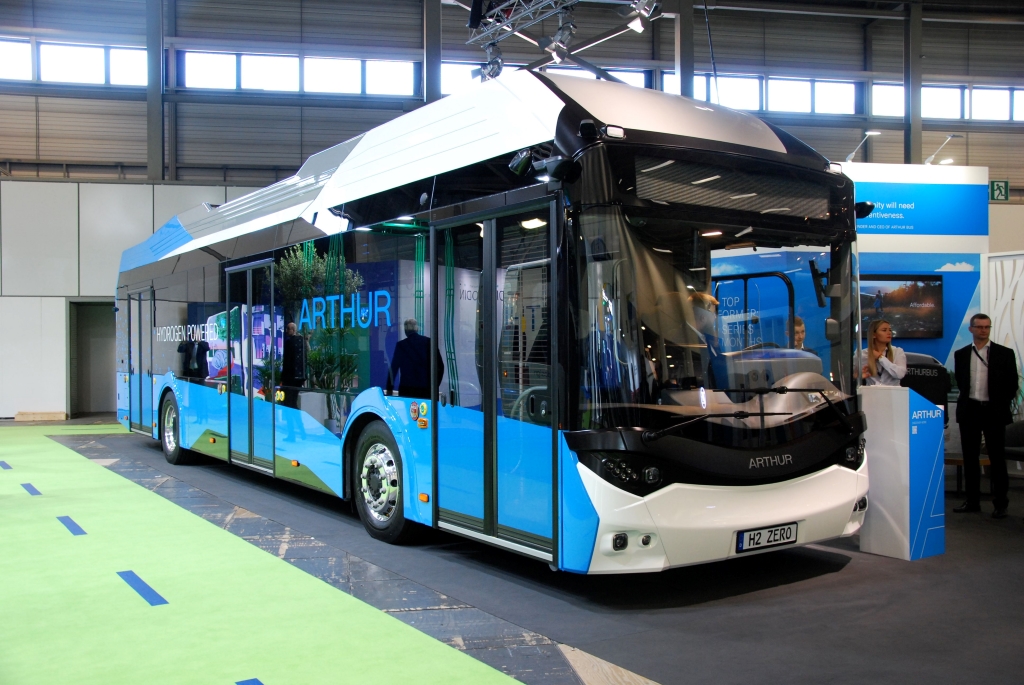
Arthur
For the first time we were able to welcome the new bus builder Arthur at the “Bus2Bus” in Berlin in April 2022. The company, based in Planegg near Munich, showed a 12-metre-long hydrogen bus with the type designation “Arthur H 2 Zero” (H 2 = hydrogen, Zero = zero emissions). Arthur was founded by the very enterprising young engineer Philipp Glonner as CEO (Chief Executive Officer) and co-founder, Rafal Slomka as Chief Technology Officer (CTO) and Gerhard May, an old hand from the automotive industry, as the main founder of the company.
At the electric bus conference, Arthur was able to present a vehicle for a customer, which will go to the municipal transport company MPK of Krakow under the operating number “PE 624”.
Arthur is committed to zero-emission buses, be they battery-electric, be they powered by hydrogen and fuel cells. There is also talk of synthetic drive concepts on Arthur’s homepage. And here you can also see drawings of Arthur trolleybuses.
Arthur wants to launch buses in lengths of 10, 12 and 18 metres – the latter articulated.
The 12-metre long fuel cell-powered solo bus has its hydrogen tanks on the roof at the height of the front axle, while the fuel cell has found its place there above the rear axle. As an “energy buffer”, the bus also has batteries, of course, which are installed in the rear of the bus.
BYD
BYD from China is no longer an unknown quantity on the German market. There are already a few larger series that BYD has been able to deliver here: 22 buses for DB subsidiary Autokraft, 22 buses to the Ruhr area for Bogestra and HCR, 17 buses for Mönchengladbach / Viersen, “only” five buses for DB subsidiary Regionalverkehr Südwest.
At the fair BYD presented a novelty, namely its battery-powered articulated bus BYD eBus-19 with a length of 18.75 metres. The vehicle was presented in the yellow of the Berlin BVG, but enquiries with the Chinese press spokeswoman of BYD Europe in Schiedam (near Rotterdam) revealed that the vehicle had nothing to do with Berlin.
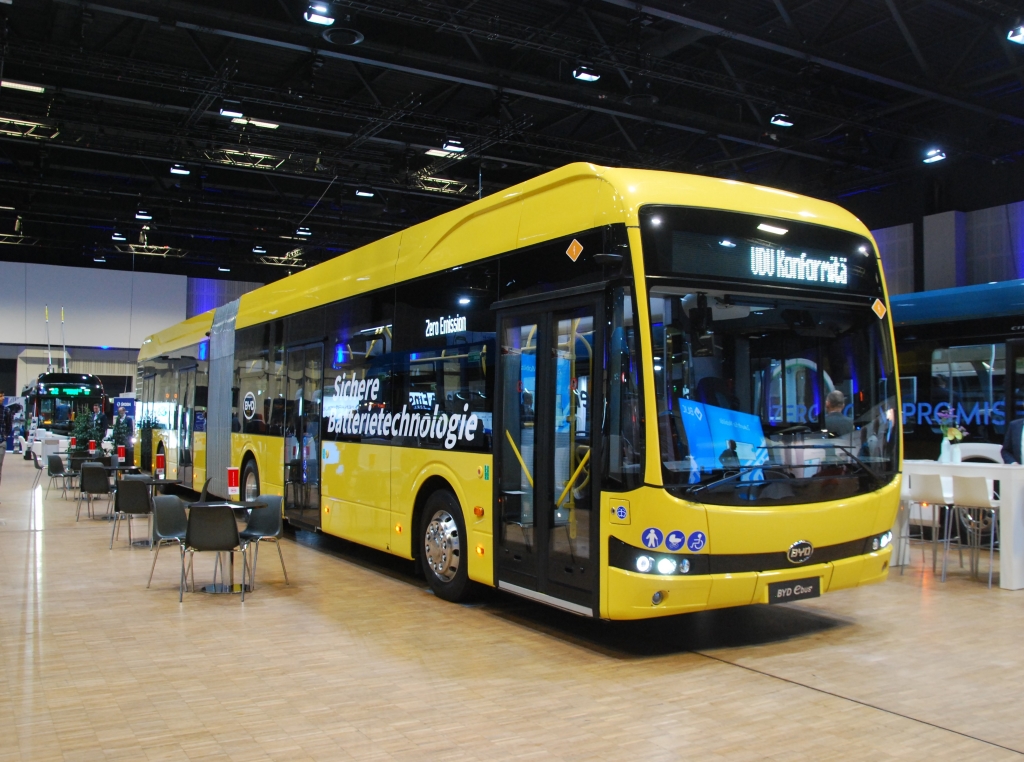

Ebusco
The Dutch electric bus manufacturer from Deurne – which recently opened a second plant in Venray (UTM reported) – exhibited two buses in Berlin. The first was the 1966 “Ebusco 2.2” of the Berlin BVG, which is part of an order for 90 buses that are currently being delivered. The “2.2” is still made of steel. Nevertheless, it already has a considerable range for the time being: Ebusco proudly reports to have driven 400 kilometres (!) without recharging with one of the new Berlin trolleys, and at the end of this venture the batteries were still 35% full. So you could have driven a lot further. Battery technology is making great progress, and research continues. (Gone are the days when people thought they had to constantly recharge, otherwise the bus would come to a standstill with an empty battery).
At the same time, Ebusco reports that its “2.2” was the winner of a tender for 20 buses at the KVS (Kreis Verkehrsbetriebe Saarlouis) in Saarlouis, in which several other electric bus manufacturers also participated. Ebusco literally: “Winning this tender once again underlines the competitiveness of the Ebusco 2.2 in terms of range and energy consumption.”
But the real eye-catcher at the Ebusco stand was its new “3.0-18 M” articulated bus. Its body is made of “composite materials” (plastic), which gives it a spectacularly low unladen weight of only 14.5 tonnes. The body is created by weaving a net of fibre plastics, which is then filled with resin. For example, a complete side wall of the bus is a single component.
The principle behind this construction is as simple as it is logical: weight that is not there and that I therefore do not have to set in motion does not cost any energy. Just how low the trolley’s own weight is can be seen from the fact that it has only single tyres on all three axles. The customer can – but does not have to ! – opt for super single tyres on axles 2 and 3, which are slightly wider and more load-bearing than conventional tyres. – In addition, Ebusco says that the composite body results in lower maintenance costs.
Since plastic does not rust, Ebusco expects the bus to last 25 years. All batteries of the bus are kept extremely flat and are installed under the low-floor floor (!) of the bus. Accordingly, the roof can be designed as a glazed panoramic roof. This is also a rather unusual detail for a regular-service bus.
Ebusco claims a range of up to 700 kilometres for its “3.0”. Even a diesel bus would have problems keeping up with that. And with this range, there is no need to recharge on the line; overnight recharging at the depot (over-night charging) is completely sufficient.
The vehicle is 18,000 mm long and can busry 150 passengers. It is available as a three- or four-door version.
Hess
Busrosserie Hess AG” from Bellach in the Swiss canton of Solothurn was represented rather modestly with a stand on the edge of Convention Hall 1. The company is now 140 years old, founded by Heinrich Hess in the cantonal capital of Solothurn, where initially – the automobile had not yet been invented – busriages were built. But Heinrich Hess “kept at it”: bodies for buss (and later also buses) were not long in coming. In the eighties (about a hundred years after the company was founded), the factory at the headquarters in Solothurn definitely became too small: it was no longer possible to grow. So they acquired a larger site in Bellach, Solothurn’s neighbouring municipality. It was so big that they thought they would not reach their limits again. What a mistake! Today, the Bellach plant is too small. The Hess representative at the fair in conversation with the author: “We have reached the limits of capacity in Bellach. The plots of land in the industrial estate have been completely allocated and built on. We would have to grow, but we can’t.” Let’s see where Hess will find new quarters. At least they have been able to open a factory for bus shells in Portugal.
Today, Hess is one of only three bus manufacturers offering double-articulated buses: (in alphabetical order) Hess, Solaris and van Hool. Double-articulated buses are especially demanded when it comes to trolleybuses, and Hess is big here in particular … Hess double-articulated trolleybuses run in Lucerne, St. Gallen, Geneve, Winterthur and Zurich, for example, and as battery electric buses recently also in Basel.
Today, Hess focuses on every type of electric drive for its buses: trolley bus (also battery trolley bus (BOB) with in-motion charging), battery bus and hydrogen bus. According to the interlocutor at the trade fair, the company has already completely abandoned diesel buses by 2020. Recently, the company had worked very closely with Scania on diesel buses. Then Scania introduced technical changes that would have made it necessary for Hess to make design changes as well. “Since the diesel bus is a discontinued model anyway, we didn’t want to invest these costs any more.” So there are no more diesel buses from Hess !
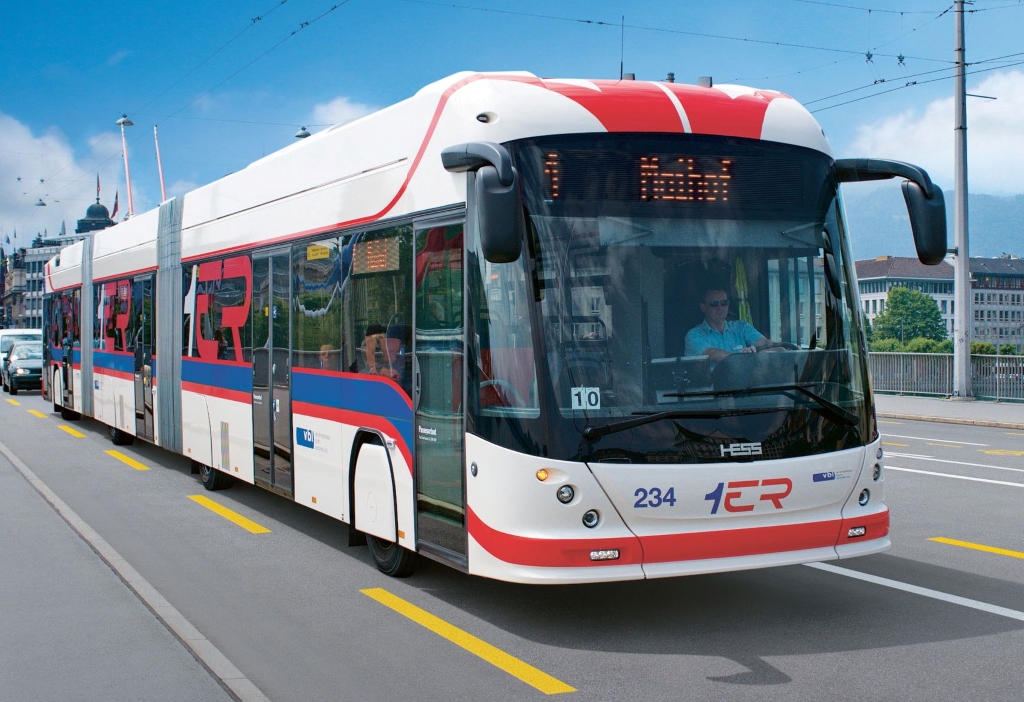
So today the production programme includes electric buses (of all types) in lengths of 10.7 metres, 12 metres, 18.70 metres and 25 metres (specifically 24.5 – for the French market .- to 24.7 metres for the Swiss market). For a long time, Switzerland held on to the “Swiss width” of 2.30 metres on the grounds that they had very narrow pass roads – this is also over, Hess now only supplies buses in the width of 2.55 metres, which is usual in Europe.
In an e-mail dated 5 April, Wiesbaden’s municipal transport company ESWE announced that it had agreed with Hess that ESWE would test a 25-metre-long, electrically driven double-articulated bus from the Swiss manufacturer in its network in June.
Holon
Autonomous shuttles for the last mile: no longer a distant vision from science fiction films. In as little as two to three years we will see them in daily use in our local public transport.
For example, Hamburg’s Hochbahn has signed a contract with Holon under which Holon will deliver such shuttles to the Hanseatic city.
You have never heard of Holon? This is not really surprising, but the start-up Holon is the subsidiary of a very well-known supplier company from the motor vehicle industry, namely Benteler from Paderborn. Benteler founded its subsidiary to take an important position in the autonomous shuttle market.
Holon’s autonomous small bus, which is deliberately asymmetrical in design, is called “Mover”. It can busry 15 passengers. Original text: “Each of our Movers is packed with high-tech: sensors, cameras, lidars and of course lots of algorithms. Together, all these things make safe autonomous Level 4 driving possible.” (Level 4 = the vehicle essentially drives completely on its own, but for safety there is still an operator on board who can intervene if necessary).
The small one has large doors, and a ramp (which of course works automatically) makes it easier for wheelchair users and prams to get in. Lettering in Braille also enables blind people to find their way around.
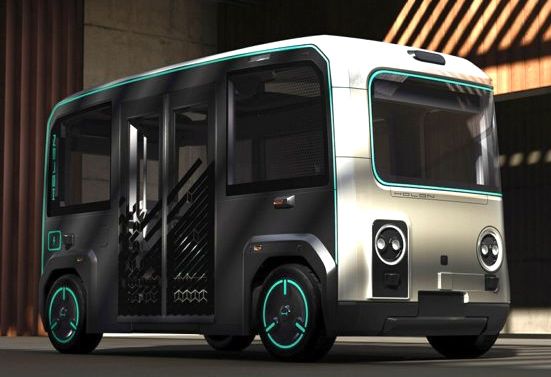
Of course, the Mover runs electrically. “Sustainability,” says Holon, “is simply part of our DNA.”
Holon is proud of his flexible production concept. Different Mover variants can easily be built on the same production line, he says. Holon concludes his presentation on the internet with a nice statement: “Built for passengers, not drivers.”
Irizar e-mobility
The Spanish bus manufacturer Irizar (from Ormaiztegi in the Basque Country) looks back on a very long tradition in vehicle construction, as the company was founded as early as 1889. Since 2011, there has been the subsidiary “Irizar e-mobility”, which builds three “families” of electric vehicles in its plant in Aduna, Spain: the buses of the “ieBus” and “ieTram” series – as well as trucks of the “ieTruck” series.
The factory was opened in 2018, the built-up area measures 18,000 sqm, and the land is 4 hectares. This should make plant expansions possible. Irizar has invested 75 million euros in the construction of this plant. It currently has a capacity of 1000 vehicles per year, but – see above – it is possible to grow on the factory site.
Irizar confidently declares that its plant in Aduna is the only plant exclusively for electric commercial vehicles in Europe.
Irizar supplies two electric bus series. One is the “ieBus” in lengths of 10,620 mm (ieBus 10), 12,160 mm (ieBus 12), 14,830 mm (ieBus 15) and 18,730 mm (ieBus 18), the other is the “ieTram” with a length of 12,160 mm (ieTram 12) and 18,730 mm (ieTram 18). The “ieBus” is based on the conventional design of city buses, while the “ieTram” borrows not only its name but also its appearance from modern trams. (A bus doesn’t really need that).
Irizar’s battery buses can be recharged in three different ways. On the one hand, there is the (slow) recharging at the depot in three to four hours. Once a day, the batteries can also be recharged in 20 to 30 minutes (fast charging). In addition, Irizar also offers recharging on the line, both via pantograph, which rises from the bus to the charging station, and via inverted pantograph, which descends from the charging station onto the bus.
In Berlin, Irizar exhibited an “ieTram 12” with bus 53 for Madrid’s urban transport company ETM, which is to operate there in a BRT network (BRT = Bus Rapid Transit, gladly on completely independent routes). Madrid has opted for the two-door version, but the bus is also available as a three-door version. The electric motor has a power output of 206 kW, and Irizar gives a range of 350 kilometres.
The German sales and service partner is Jebsen & Jessen in Hamburg, which also works for the British bus manufacturer Mellor.
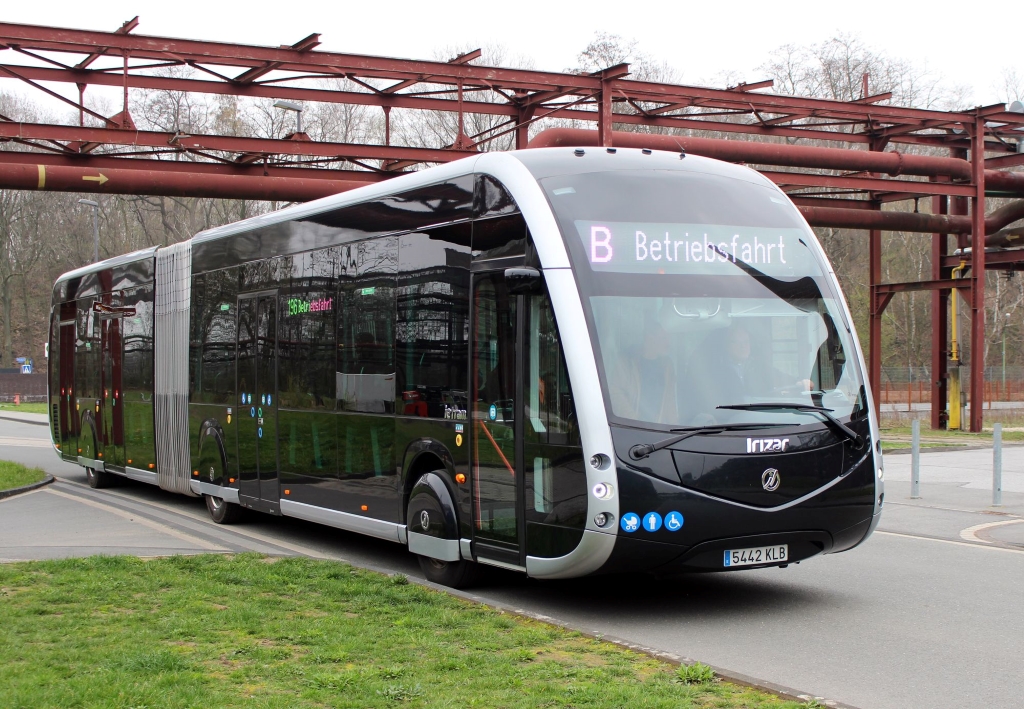

Iveco
Meanwhile, Iveco is also quite successful in the electric bus market. Within the group, the sister company Heuliez from Rorthais in north-eastern France is responsible for the construction of these vehicles. They are marketed under the series name “E-Way”.
The E-Way is available from “very small” to “very large”, namely in lengths of 9,510 mm, 10,740 mm, 12,050 mm and 17,960 mm (the latter of course being the articulated bus). What they all have in common is the height of 3,350 mm.
Depending on the customer’s wishes, they can be supplied with both high-capacity and “flex” batteries. Iveco relies on lithium-ion batteries. They are designed either for slow recharging of the batteries overnight in the depot or on the line via pantograph. The customer can choose how many batteries his bus should have and thus adapt it to the special requirements of his particular area of operation. Where not so much battery capacity is needed, the bus does not have to busry so many batteries and can busry more passengers accordingly.
The electric motors of the E-Way have an output of between 160 kW (on the smallest model) and 200 kW (on the articulated vehicle).
A speciality of Heuliez are windows on the left side of the bus even below the usual window sill line. This clearly distinguishes the buses from the products of the competition, and of course provides more natural light inside the bus.
MAN
At the electric bus conference MAN showed a bus of its type “MAN Lion’s City 12 E”, which stores its traction current in batteries. It is part of the electric bus family of the brand with the lion, which consists of the models “Lion’s City 10 E”, “Lion’s City 12 E” and “Lion’s City 18 E”.
The buss can have up to eight battery packs, giving them a range of up to 350 kilometres. During a test run (“eBus Efficiency Run”) from 3.40 a.m. in the morning until 4.00 a.m. the next morning (i.e. 24 hours and 20 minutes) on lines of the Munich public transport company, the bus even reached 550 kilometres. The trolley was not travelling empty, so that it would not have had to “haul” much, but the load from passengers was simulated with weights.
As an articulated vehicle, the MAN Lion’s City 18 E can busry 138 passengers – depending on the equipment. And with a range of 350 kilometres, the bus can run on its route from early in the morning until late at night without having to recharge – which is what the “eBus Efficiency Run” showed. A capacity of 138 passengers also relegates the claim that electric buses can only busry far fewer passengers than other buses to the days of a long-gone past.
The MAN Lion’s City 10 E is 10,575 mm long, the Lion’s City 12 E is 12,200 mm long and the articulated Lion’s City 18 E is 18,100 mm long. All three are driven by electric central motors, whereby the articulated wagon even has two driven axles with a central motor on each axle.
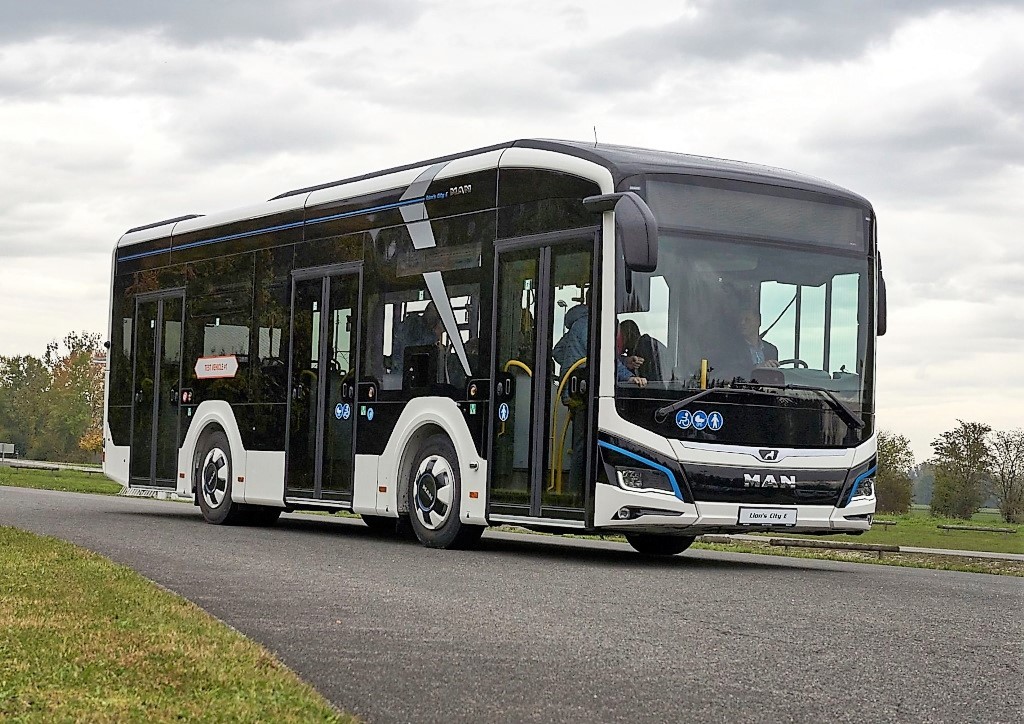
MCV
There was also a world premiere at ElekBu: the battery-electric MCV C 127 EV from the Egyptian manufacturer MCV (Manufacturing Commercial Vehicles). It is a twelve-metre-long solo vehicle that MCV has developed especially for the European market. The prototype was on display at the fair. The C 127 EV is now to go into series production initially as a battery-electric bus; the version with a hydrogen fuel cell is looking forward to its market debut soon.
In addition, MCV plans to produce a vehicle with a length of around 10 metres and an articulated bus in the near future.
MCV has founded a German sales and service company (MCV Deutschland GmbH) based in Bestwig, Sauerland. At the helm are three “old hands” in bus construction: Messrs Dellori, Grau and Schneider.
In the battery-electric version, the C 127 EV has its accumulators on the roof. A look inside the bus is quite convincing: the bus makes a busefully crafted impression, the gaps between two adjacent panels of the interior panelling are “correct”. Even if we don’t know buses from (North) Africa in Europe for the time being: the MCV shows that professionals are working here.
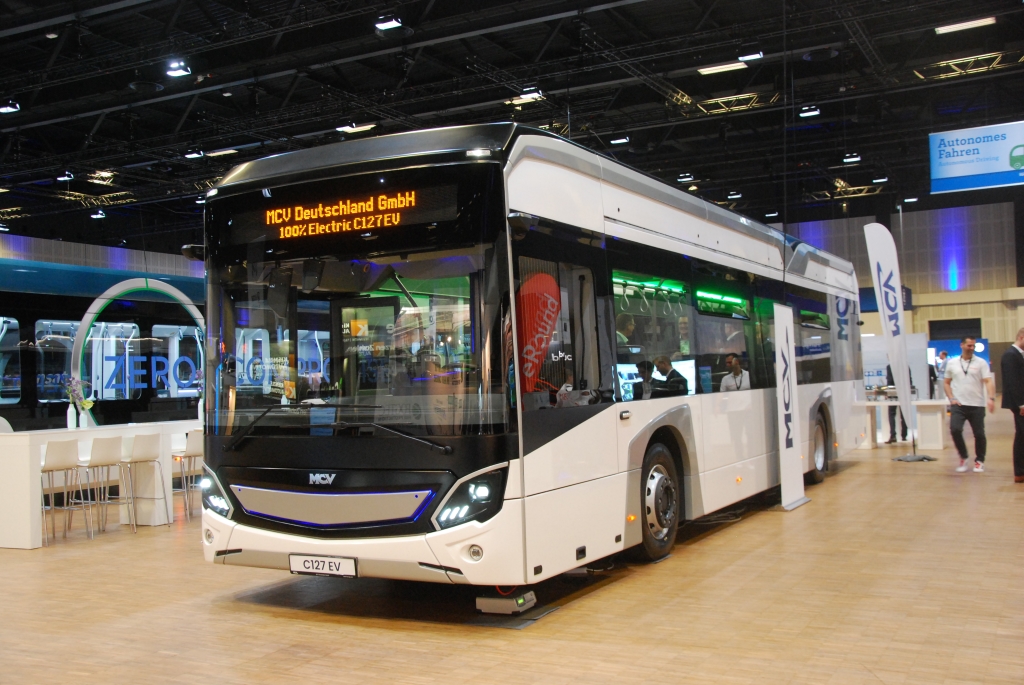

Mellor
Mellor
Mellor from Rochdale in the UK is still very new on the German market, even though the company claims to have been in the bus building business for 60 years. Up to now, they have mainly been involved in converting vans such as the Iveco Daily, the Fiat Ducato, the Mercedes Sprinter or the Volkswagen Transporter into minibuses. Entering the size class of up to 12 metres, i.e. building “full-grown buses”, is new for Mellor. – In Germany, the manufacturer is represented by the Hamburg company “Jebsen & Jessen” (see also under: Irizar).
The factory building in Rochdale measures 2,510 square metres, 500 buses can leave the factory every year.
Mellor will supply its “Sigma” family of electric buses to the German market, with models in six lengths ranging from 7 to 8, 9, 10 and 11 metres to 12 metres. The fully low-floor Sigma 7 is 7 metres long and 2.1 metres wide and can busry up to 31 passengers. Due to the narrow body, Mellor offers it with two seats on one side of the aisle and only one seat on the other.
Its next two larger brothers, Sigma 8 and 9, measure 8.7 and 9.4 metres in length, are 2.35 metres wide and can busry up to 60 passengers. Both are low-floor buses, but the Sigma 9 is also available as a high-floor bus.
The Sigma 10 is 10.2 metres long, a dimension that is far more common in Britain than here. Mellor recommends it for lines where a double-decker of this length could not be used. (A double-decker with a length of only 10.2 metres? In our country, double-deckers, if they are used at all, tend to be much longer than 12 metres, see the last double-deckers for Berlin, the MAN Lion’s City DD and the Alexander Dennis Enviro 500, both of which are more than 13.5 metres long).
Finally, there are the two largest Sigma, the “11” and the “12”. They have a width of 2.55 metres, which is usual in Europe, and the “longest” Sigma 12 is exactly 11,997 mm long. Especially it then also offers a passenger capacity that is common for buses of this size.
The batteries of the Mellor Sigma come from the Chinese manufacturer CATL (Contemporary Amperex Technology Limited), the world leader in battery construction. Its accumulators are used in electric vehicles all over the world.
Sigma has already received its first order from Germany: the Kiel transport company KVG has ordered three Mellor Sigma 7s, which are scheduled to go into operation before the end of 2023. And a Sigma 7 has already toured Germany as a demonstration vehicle. At the electric bus conference, a Mellor Sigma 7 was shown for the Swedish “Västtrafik” (Gothenburg region).
Menarinibus (Industria Italiana Autobus – IIA)
After its first appearance at the Electric Bus Conference in Berlin last year, Menarini presented itself for the second time in Berlin this year. And this year on a joint stand with the Portuguese bus builder Caetano. Menarini does not have its own fuel cell, but uses technology from Caetano and Toyota.
Menarini has just won a tender from SASA in Bolzano/Bozen (South Tyrol) for five hydrogen buses. The buses will have fuel cells from Caetano/Toyota.
Menarini’s Citymood 12 e – shown at the electric bus conference – is 12,100 mm long and 2,550 mm wide. It is powered by the Siemens electric motor “PEM 1080216 6NB06” with an output of 230 kW. It is a three-door bus and thus corresponds to a current trend in bus construction, on the one hand, and on the other hand, people in Italy have always loved buses with many doors in city traffic – four-door (!) 12-metre buses were not uncommon in Italy. Depending on the equipment the customer chooses, the bus can offer between 24 and 28 seats.
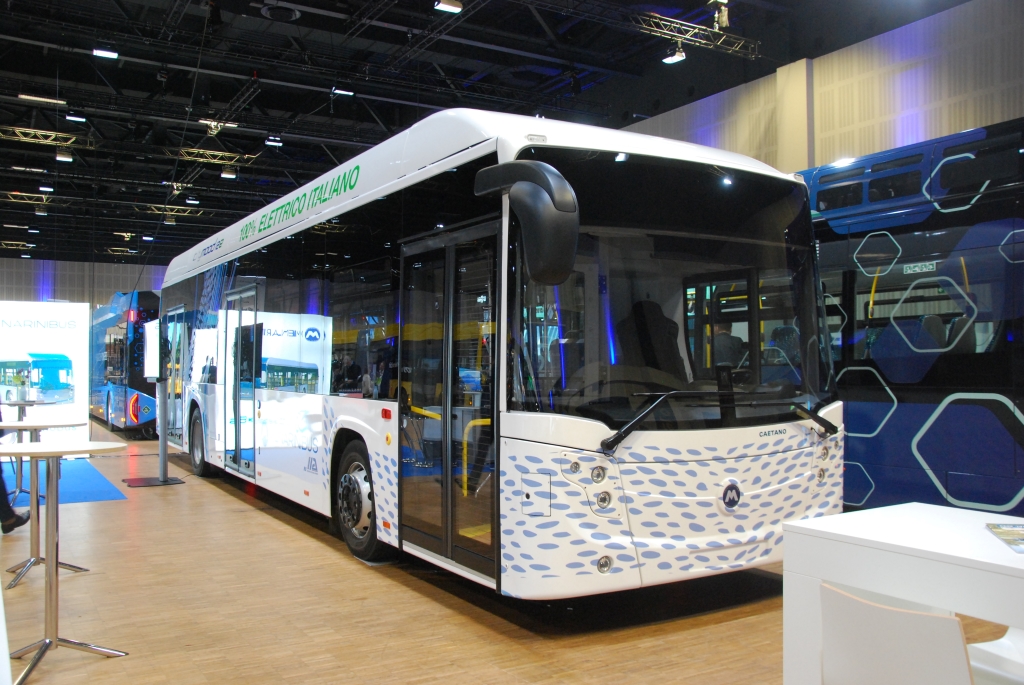
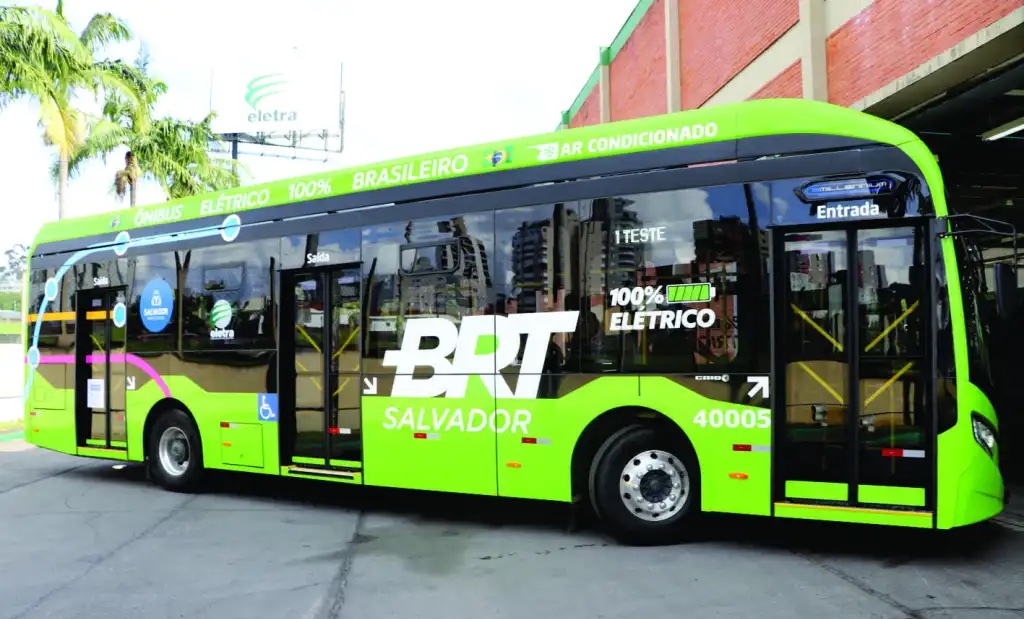
Mercedes-Benz
Mercedes showed its well-known “eCitaro” in the exhibition, a model with which it is now quite successful on the market. In Germany, the house with the star is now number 1 in the registration statistics, in Europe it is number 3 (after VDL and Solaris). The bus shown was a two-door model, but it is also available as a three-door model (each 12,135 mm long) and as a three- or four-door articulated bus with a length of 18,125 mm. The height is uniformly 3,400 mm.
They are all driven by electric motors close to the wheel hub on the ZF AVE 130 electric axle, which have a continuous output of 125 kW (equivalent to 170 hp on a diesel bus). The vehicle can be equipped with several of these motors. In addition, an electric motor is anyway more powerful in terms of sprinting and hill-climbing than a diesel engine.
For the batteries, Mercedes relies on lithium-ion accumulators, which in the case of the solo vehicle are accommodated in modules on the roof and at the rear of the bus in groups of two, four or six. The articulated vehicle can have up to twelve batteries. The battery cells work with nickel-manganese-cobalt (NMC) chemistry. In the solo bus they can have a total capacity of 292 kWh, in the articulated bus 396 kWh. It should be reported that Mercedes is not only intensively researching to increase the range of its batteries, but above all to develop new accumulators. In particular, the brand with the star expects a significant increase in the range of its electric buses from so-called solid-state batteries, which can store significantly more electricity. And in the future, it wants to build its own batteries: together with Volvo Truck, it has founded a company that will manufacture batteries for both manufacturers in Weilheim (Esslingen district) in Baden-Württemberg. This will make them independent of Chinese suppliers.
Mercedes emphasises that its electric buses can be equipped both for overnight charging at the depot (over-night charger) and for recharging on the line.
It remains to report on an interesting delivery to a Brazilian customer, namely to the city of Salvador Bahia. Although “only” eight electric buses have been delivered so far, it is a considerable export success. The vehicles are based on the Mercedes chassis “OC 500 U” and have bodies from the Brazilian bodybuilder “Caio Indusbus”, which has been supplying buses since 1946.
And most recently, Daimler Truck has reported an order for 35 Mercedes-Benz eCitaro articulated buses for the Dutch provinces of Groningen and Drenthe.
Otokar
Otokar from Bursa in Turkey produces an extensive range of electric buses. The 12-metre-long “eKent C” and the articulated “eKent 18” are the main examples. Otokar is a Turkish company, and in Turkish language “Kent” stands for “City”.
In Berlin, Otokar limited itself to presenting its midibus “eCentro”. The vehicle is 6,605 mm long, 2,240 mm wide and 2,895 mm high. Depending on the selected equipment, it can busry up to 32 passengers. Its electric motor, type “TN 4”, comes from the US manufacturer Dana, and it has two batteries with a total capacity of 110 kWh (2 x 55 kWh), which give it a range of 200 kilometres.
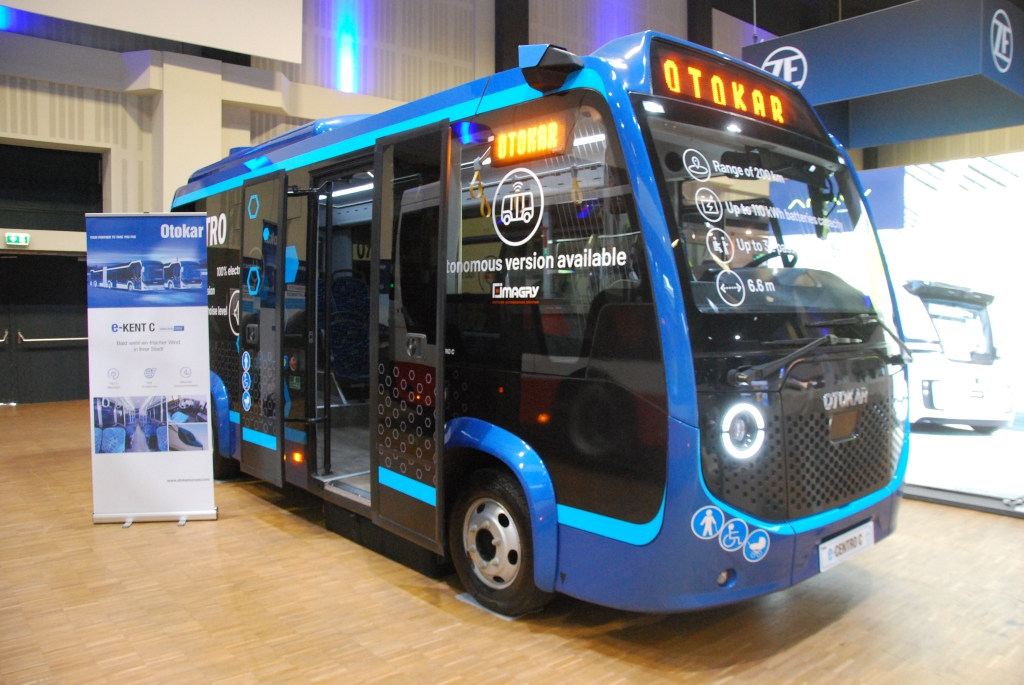

Quantron
Quantron, a newcomer from Augsburg, was represented at the electric bus conference with a small stand. For the bus, the manufacturer relies on its “Quantron Cizaris 12 EV”. It is a 12,180 mm long solo vehicle with a range of up to 370 kilometres. Its electric motor has an output of 245 kW, it can busry between 81 and 95 passengers, depending on the equipment, and offers between 25 and 36 seats. It has a top speed of 80 km/h and a gross vehicle weight of 19,500 kg.
Solaris
Solaris, bus manufacturer from Bolechowo (near Poznan) in Poland, showed an Urbino 18 electric in the brand new version with two driven axles.
Solaris is still one of the manufacturers that build the most buses with alternative drives. In Germany, they are in second place in terms of the number of such buses registered – after VDL from the Netherlands and ahead of Mercedes. In Europe, the situation is somewhat different, with the Chinese manufacturer Yutong in first place, who, remarkably, is still rather unknown in Germany of all places. But Solaris is also one of the big players in Europe.
For a few years now, Solaris has belonged to the Spanish CAF Group, and since the beginning of the year, Javier Iriarte has been the CEO of Solaris. He comes from the “mother house” CAF. He has a clear vision for the future of Solaris: to use and strengthen synergy effects with the other companies of the CAF group.
In 2022, for the first time in its history, Solaris will have sold more buses with alternative drive systems (such as battery, hydrogen and trolley buses) than diesel buses, which only accounted for 45 % of total sales. So the end of the diesel bus is on the horizon.
1,492 buses in total could be sold by Solaris in 2022, of which 823 have an alternative drive. The biggest customers for electric buses were Linjebuss from Norway with 183 buss, ATM from Milan with 140 electric buses and Riga in Latvia with 35 electric buses. Five hydrogen buses went to Palma de Mallorca and four to Venice. Arnhem in the Netherlands placed an order for ten Solaris Trollino 18 BOBs (battery trolleybuses, in-motion chargers) in metro-style design. With these buses, Arnhem will say goodbye to pure trolleybuses in favour of vehicles that cover long distances on their routes without overhead contact lines. The ten BOBs are needed for a line extension of line 1 beyond the current terminus in Arnhem’s neighbouring town of Oosterbeek to Wageningen – not a single metre of new catenary is to be installed for the line extension.
The Solaris Urbino 18 electric shown in Berlin was, as mentioned, a novelty. It is driven on axles 2 and 3 and has four electric motors, each producing 125 kW. This gives the bus an output of 500 kW (!) – if you convert this into horsepower for fun, you will be amazed at what a “projectile” this new Solaris is. The four electric motors are located in pairs in each of the two drive axles.

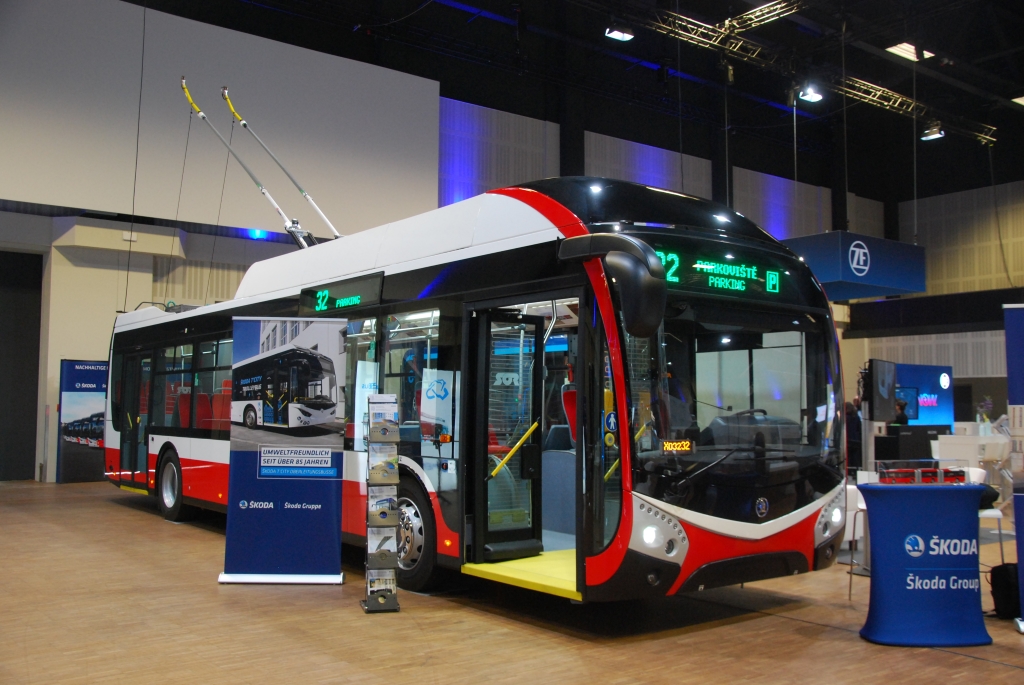
SOR
SOR based in Libchavy in the Czech Republic showed the only trolleybus at the electric bus conference on a joint stand with Skoda Transportation. The company started in “socialist” times as a repair company for motor vehicles, after the “Wende” they also began to build brand new buses themselves. In its home country, the Czech Republic, SOR is doing quite well, but in Germany it is still one of the “exotics”. The biggest customer for SOR buses in Germany is probably Vetter from Zörbig in Saxony-Anhalt, which has several examples of a SOR low-entry bus that clearly shows its step inside the vehicle – which, in the author’s opinion, gives it a somewhat peculiar appearance. Recently, Vetter has also been operating these buses in the south-western Berlin area, where it won a corresponding tender.
On the joint stand with Skoda Transportation, SOR showed a 12-metre long trolleybus of its type “TNS 12”, a – in the opinion of the author – visually very appealing vehicle. The electrical equipment of this trolleybus comes from Skoda. Which is why Skoda also likes to market it as a Skoda.
But that brings us to a problem – according to German law. In this country, according to the legal definition, the manufacturer of the vehicle is the one who made the chassis / floor assembly. And in the case of this trolleybus, that is clearly SOR – and not Skoda as the supplier of the electrical equipment.
Skoda has an interesting task ahead of it. After the fall of communism, the industrial group Skoda was split into “Skoda Auto” – today a subsidiary of the VW group – and “Skoda Transportation” for railways, trams, other public transport … Today, both companies have nothing to do with each other.
The Volkswagen Group was looking for a “clean-up”, and so they bought – for a lot of money – the trademark rights, the brand name and the company symbol, the flying Indian arrow, from Skoda Transportation. From 2029, Skoda Transportation will no longer be allowed to call itself “Skoda” – after all, they sold voluntarily – so a new name will have to be found. It will be exciting to see what Skoda Transportation will call itself in the future. And no less exciting when they will “creep” in a new name.
Steinborn
Steinborn, a specialist for minibuses and midibuses, is based in Erbach (near Ulm !). They supply such vehicles from various manufacturers, such as Cento from Romania, Esref from Turkey, Ferqui from Spain and Komvek from Turkey. Steinborn says: “It is precisely because we work with so many bus builders that we can offer a wide variety of buses.” And it is emphasised: “Every bus in our range can also be delivered as an electric bus.”
Steinborn had brought a Volkswagen Crafter to the electric bus conference, which has been equipped as an electric bus in Erbach. The bus with its nine seats is an ideal vehicle for community bus systems, he said.
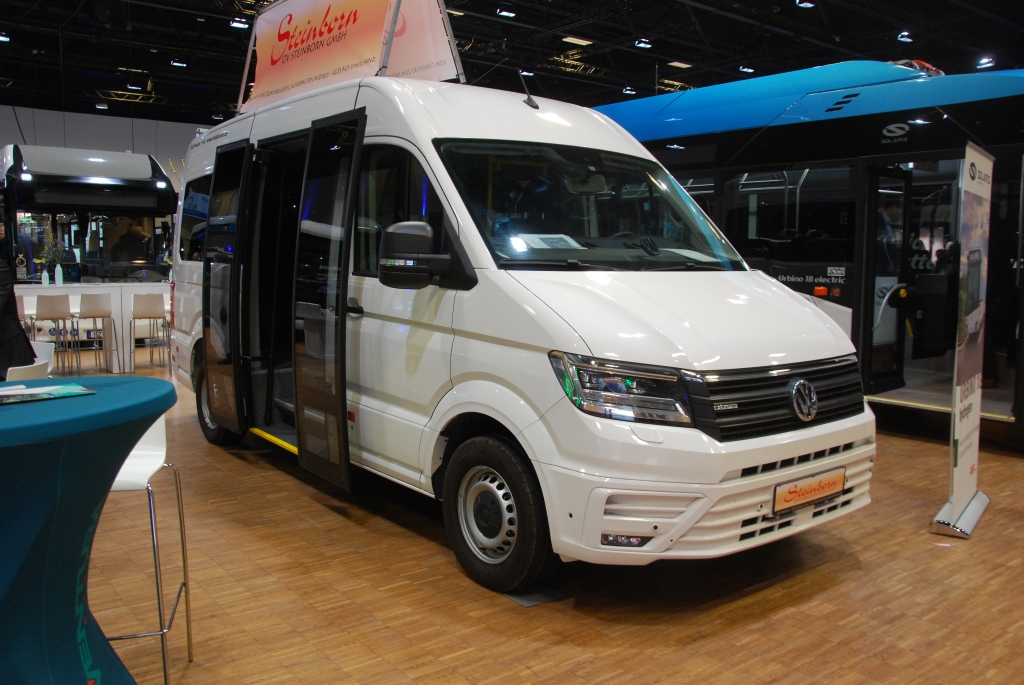
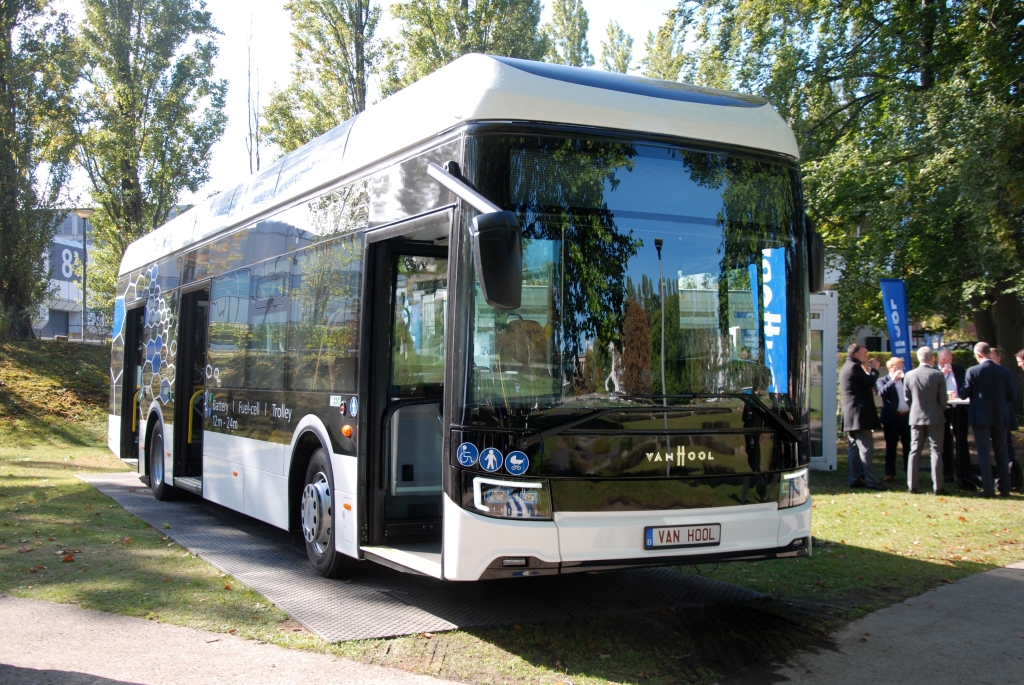
Van Hool
Van Hool, a bus manufacturer from Lier(-Koningshooikt) in Belgium with a branch in Skopje in northern Macedonia, showed its new battery-electric city bus “A 12”. The vehicle shown (with a twin) goes to the Rhein-Main Verkehrsverbund (RMV) and is to be used in the greater Giessen area.
Van Hool – like Hess and VDL – has completely renounced diesel buses with the new “A” series. The reason, as with the two competitors: “Diesel? That used to be!” Van Hool offers its new “A” bus family with all conceivable electric drives, i.e. battery, fuel cell and trolley buses, and in lengths of 10, 12, 15 and 18 metres as well as double-articulated buses. Van Hool prides itself on being able to react flexibly to customer wishes. Recently, Qbuzz from the Netherlands ordered 54 fifteen-metre-long low-entry buses of the new “A” series with bus seating from van Hool (urban-transport-magazine.com reported). “Our designer had to think a bit about that, but he found a solution, Qbuzz gets the bus it wanted.”
VDL
VDL came into being at the beginning of this millennium as a merger of no less than five bus manufacturers from the Netherlands and Belgium. These were: Berkhof from Heerenveen (NL), Bova from Valkenswaard (NL), Denolf & Depla from Roeselare (B), Jonckheere from Roeselare (B) and Kusters from Venlo (NL). The new brand name VDL was found for this merger, and that stands for the name of the family of the multi-hay owners: van der Leegte.
VDL’s task was to create a unified portfolio from the product lines of five bus manufacturers. This was achieved surprisingly quickly and well. Today there are two product families: the regular service buses called “Citea” (pronounce that in English) and the buses called “Futura” (which sounds – certainly not without reason – like “future”). Even the double-decker bus “Synergy” from Berkhof has meanwhile turned into a Futura (“Futura DD”), not only visually, but above all technically.
VDL is currently the number 1 electric bus manufacturer in Germany. This is largely due to Cologne’s KVB, which will soon have well over 100 electric buses from VDL in operation. They are currently building a special electric bus depot for them in the Porz district. It is not even finished yet, but has already grown considerably compared to the first plans …
At the electric bus conference VDL showed its new battery bus type “LF-122” (LF = low floor, 122 = length in decimetres). With the new generation VDL is definitely saying goodbye to the diesel bus, for which they no longer see a future. In Roeselare, Belgium, a completely new factory has been built for the new Citea, where, for example, attention has been paid to directing the natural light in such a way that the employees’ stay at the workplace is as pleasant as possible.
The new Citea is one of the new buses that no longer have a steel body. Its body is also made of “composite” material, and its side wall, for example, is also only one piece. This is also done to reduce the weight of the bus. Its batteries are also located under the completely flat low-floor floor.
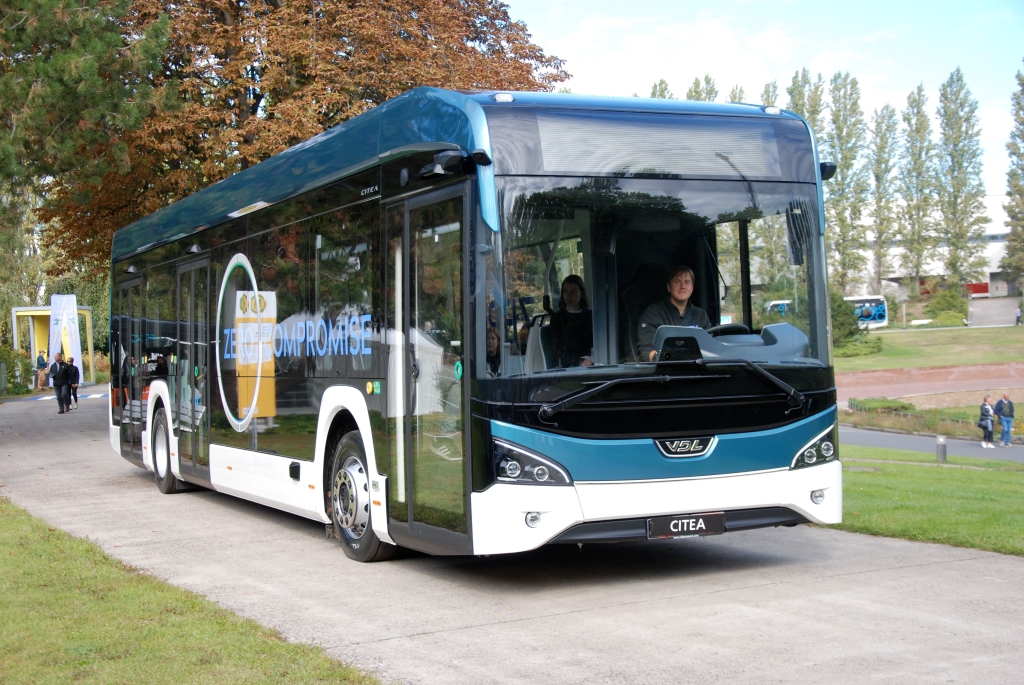
.
02.05.2023
